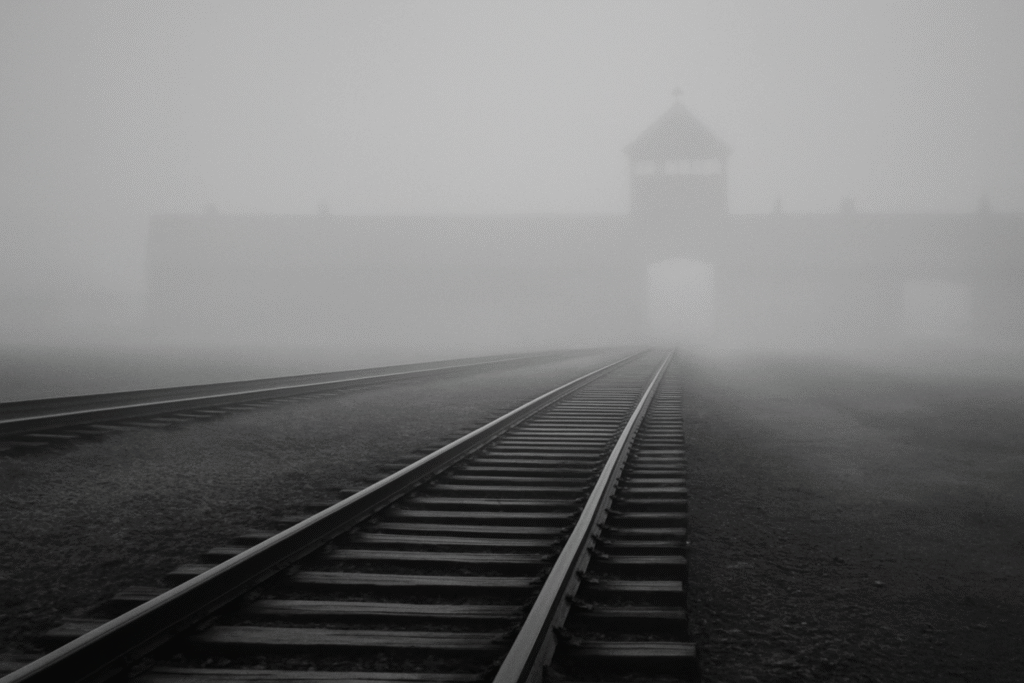Before it became the most infamous site of genocide in human history, Auschwitz was a quiet Polish town with military barracks. Understanding how it was transformed into the largest Nazi concentration and extermination camp is essential for grasping the broader context of the Holocaust and World War II.
In this article, ‘Auschwitz’ refers to the entire complex – Auschwitz I, Auschwitz II-Birkenau and Auschwitz III-Monowitz – unless otherwise specified.
Oświęcim Before the War
The town of Oświęcim has a long and complex history, dating back to the Middle Ages. By the early 20th century, it was a modest town in southern Poland with a diverse population, including a significant Jewish community. In the interwar period (1918–1939), it was part of the Second Polish Republic.
Located at a strategic railway junction in southern Poland, Oświęcim was home to Polish army barracks built before World War I. These barracks later became the foundation for the Auschwitz I camp.
The Establishment of Auschwitz
After Nazi Germany invaded Poland on 1 September 1939, the region around Oświęcim was annexed to the Third Reich. The name of the town was Germanised to Auschwitz, and the area was incorporated into the province of Upper Silesia.
The SS chose the site for a new concentration camp in the spring of 1940. It was considered ideal because of the existing barracks, its secluded location and its railway connections. Heinrich Himmler approved the plan, and SS officer Rudolf Höss was appointed as commandant. In early May 1940, Höss arrived to convert the former Polish Army barracks in the Zasole district into what became Auschwitz I. On 20 May 1940 the SS brought 30 German criminal prisoners from Sachsenhausen to serve as functionaries (kapos). They were assigned prisoner numbers 1–30.
The first transport of prisoners – 728 Polish political prisoners – arrived from Tarnów on 14 June 1940. Most were resistance members, intellectuals, teachers and clergy. The youngest was only 16 years old. The first registered Polish prisoner was Stanisław Ryniak (no. 31). The initial purpose of the camp was to intimidate and incarcerate the Polish population and to relieve overcrowded prisons in occupied Poland.
Expansion: Birkenau and Monowitz
As Nazi persecution escalated, the Auschwitz complex expanded rapidly. In 1941 a new camp – Auschwitz II-Birkenau – was begun, initially intended to hold large numbers of Soviet prisoners of war. In 1942 provisional gas chambers (the so-called Bunkers) went into operation, and by 1943 four large crematoria with gas chambers (II–V) had been completed. Birkenau became the main site of mass murder, with selections on the ramp and the murder of Jews deported from across German-occupied Europe, as well as Roma (Sinti and Roma). The killings peaked in 1944 during the deportations of Hungarian Jews, when open-air burning was also used.
In 1942 Auschwitz III-Monowitz (Buna) and forced labour for IG Farben were established to supply prisoner labour to a vast synthetic rubber and fuels plant nearby. Other companies, including Siemens and Krupp, also drew on prisoner labour from Auschwitz. Conditions were brutal: starvation, disease, exhaustion and violence produced extremely high mortality. The complex eventually comprised dozens of subcamps (over forty). The SS leased prisoners to firms for a daily fee, creating a system in which many businesses profited from enslaved labour, even if not all were directly involved in the mechanics of genocide.

A Killing Centre
By 1942 Auschwitz had become a central hub of the Nazis’ ‘Final Solution’. Deportees – Jews from across occupied Europe, as well as Roma (Sinti and Roma) and other victims – arrived in sealed cattle cars. On the ramp at Birkenau SS doctors carried out selections: most people were sent directly to the gas chambers, while others were assigned to forced labour in conditions of starvation, disease and violence. Zyklon B became the primary killing agent in gas chambers attached to the crematoria.
Mass murder and exploitation operated side by side. Birkenau’s crematoria II–V enabled killing on an industrial scale, while subcamps across the region supplied enslaved workers to SS-run enterprises and private industry. In total, over one million people – the vast majority of them Jews – were murdered in the Auschwitz complex. For the background to estimates and sources, see Victims and Survivors of Auschwitz.
Conclusion
The transformation of Auschwitz from a Polish town with military barracks into the largest killing centre of Nazi Germany is a harrowing reminder of how ordinary infrastructure can be repurposed for evil. The historical development of this site is essential to understanding the mechanisms of the Holocaust and the necessity of remembrance.
Figures cited here reflect post-war investigations and decades of historical research. Where precise totals are impossible, we use well-established estimates explained in the articles linked below.
Read next
The Structure of the Auschwitz Complex: Auschwitz I, Birkenau, Monowitz
Forced Labour and Industry around Auschwitz: Monowitz and IG Farben
Liberation of Auschwitz and the Memory of 27 January
Victims and Survivors of Auschwitz: Numbers, Sources, Testimonies
Resistance and Escapes from Auschwitz
If you are planning to visit, explore our guides to visiting Auschwitz for practical tips and different tour options.
